Abstract
Long-term synaptic facilitation at the connections of Aplysia sensory neurons onto their target cells involves alterations in gene expression. How then are the relevant cellular signals for the induction and expression of long-term synaptic changes conveyed between the nucleus and remote synaptic terminals? We have explored this question using a set of remote, peripheral terminals of siphon sensory cells, which are approximately 3 cm from the sensory cell body in the abdominal ganglion. We found that these remote synapses, like the proximal synapses previously studied in dissociated cell culture, can exhibit long-term facilitation 24 hr after cell-wide serotonin application. Furthermore, serotonin applications restricted to the remote synaptic terminals nevertheless produced long-term facilitation, indicating that signals generated in synaptic regions can trigger the long-term process, perhaps via retrograde signals to the nucleus to modify gene expression, followed by anterograde signals back to the terminal. Serotonin applications restricted to the cell body and proximal synapses of the sensory neuron also produced long-term facilitation at remote synapses, although to a lesser extent, suggesting that long-term facilitation is expressed cell-wide, but that superimposed on this cell-wide facilitation there appears to be a component that is synapse-specific.
Full text
PDF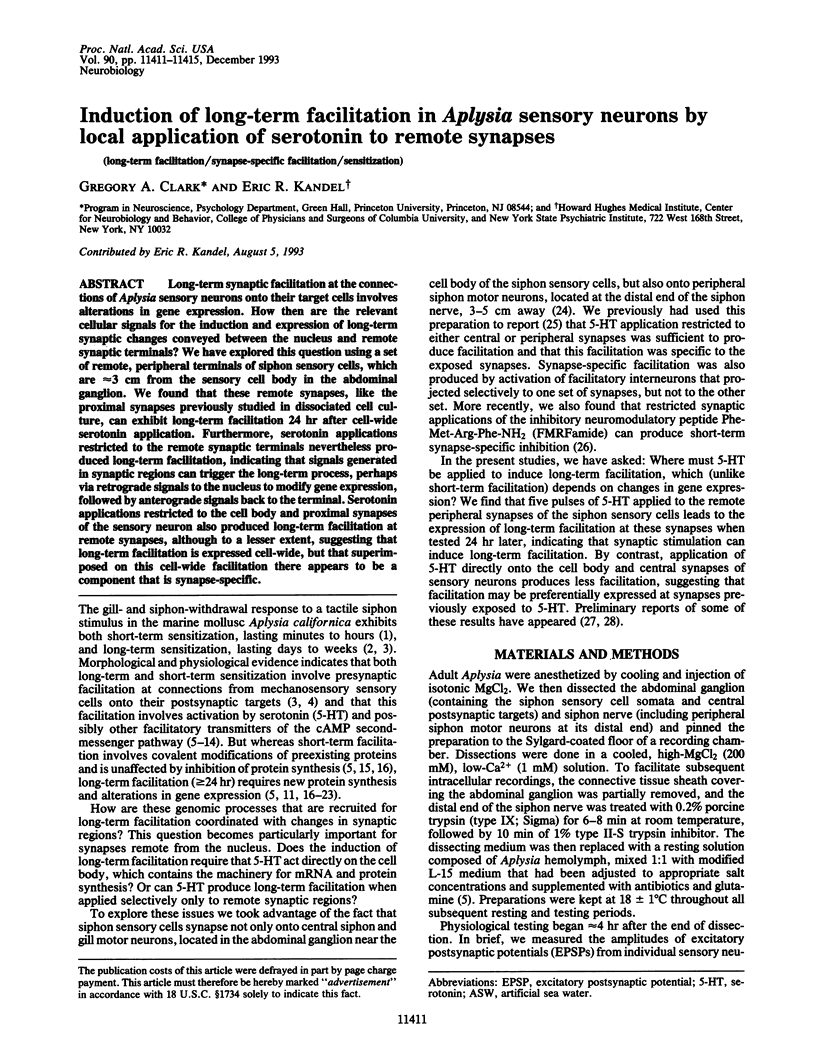
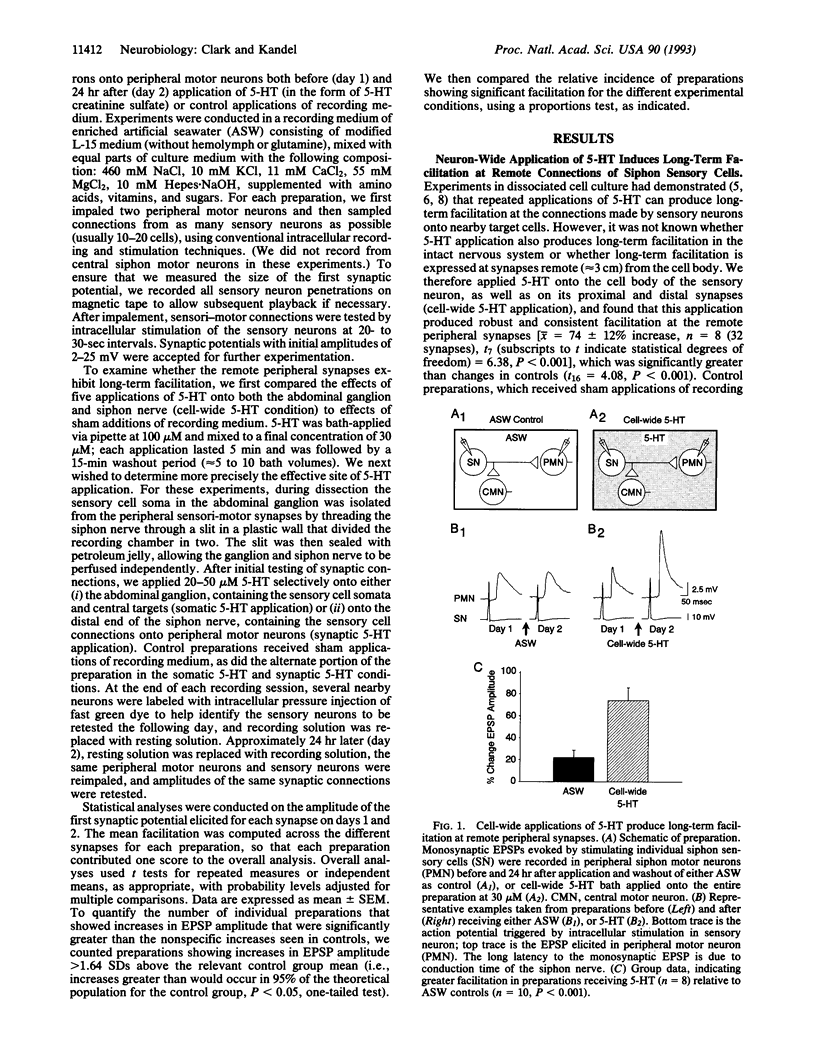
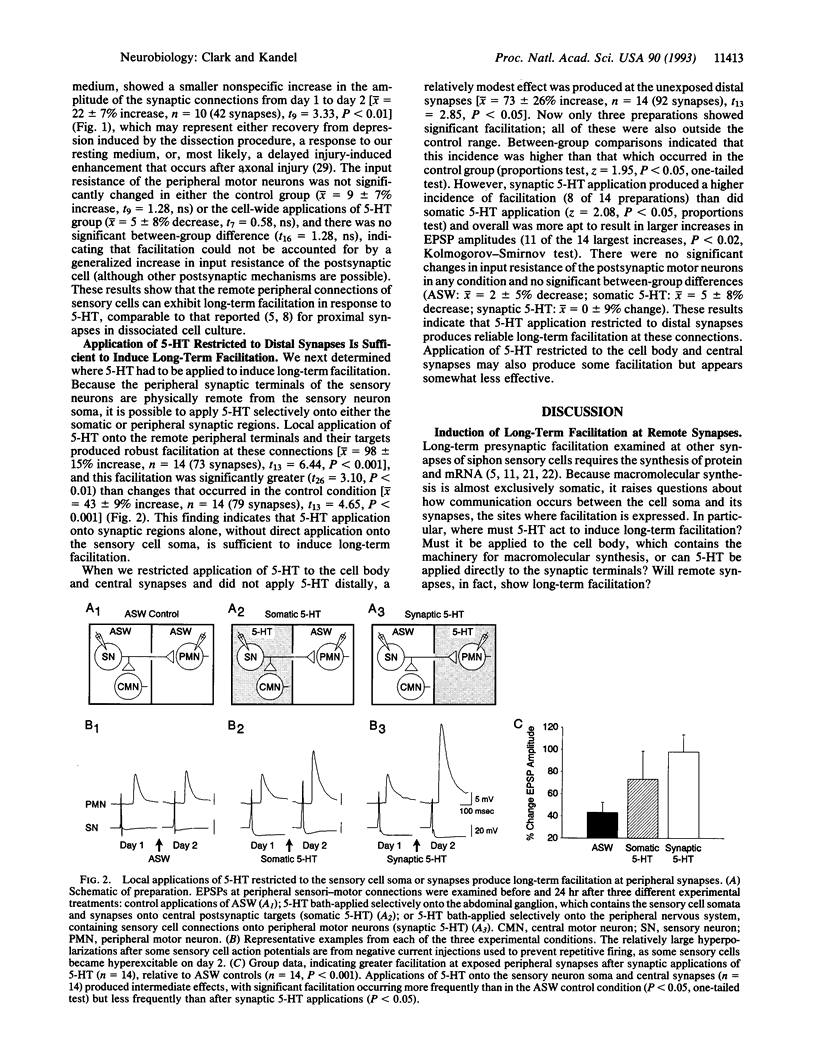
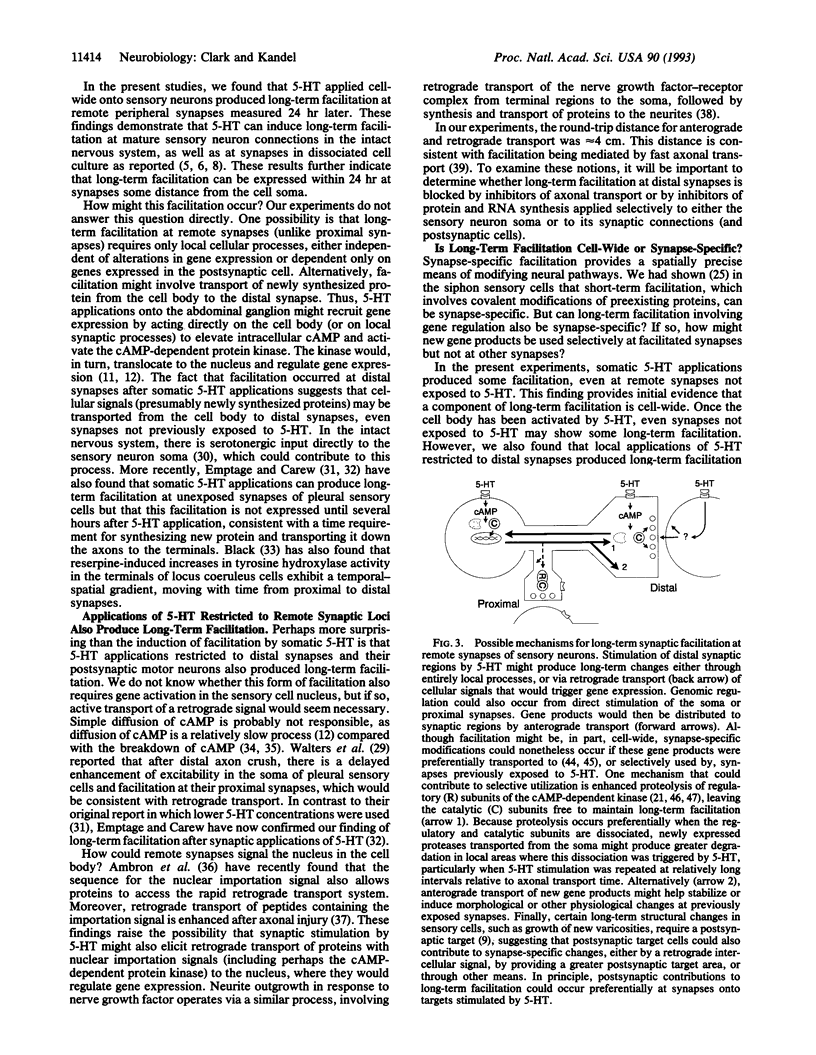
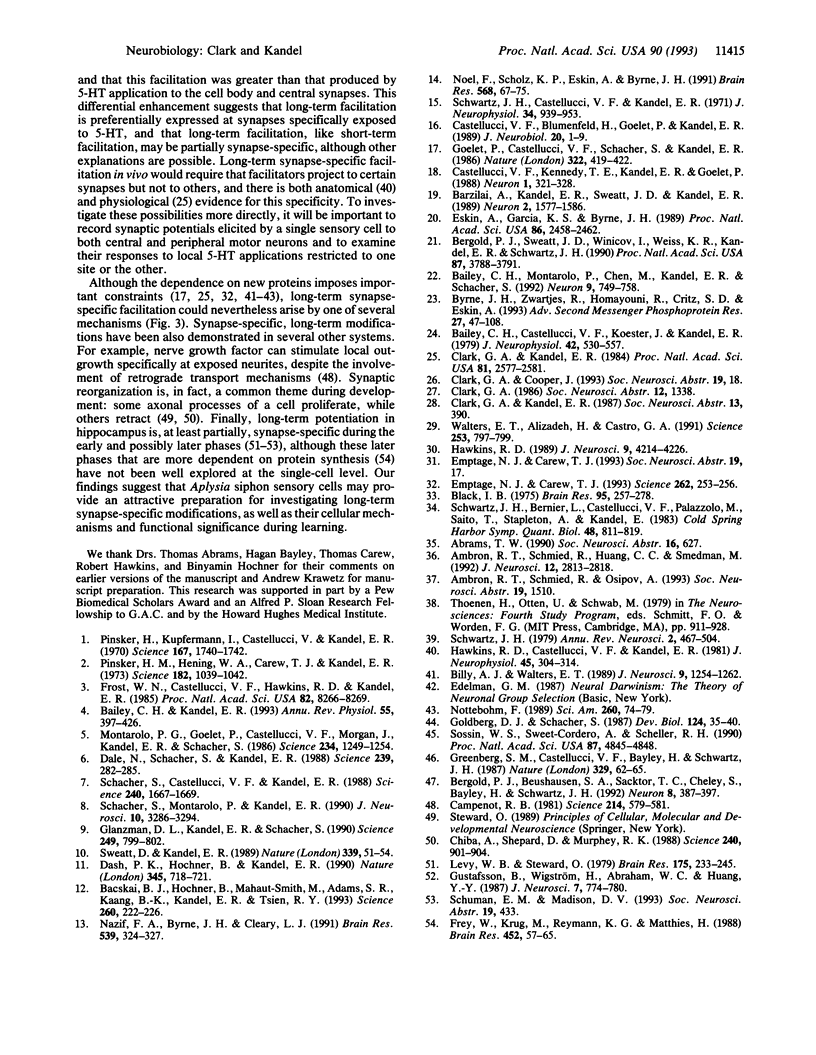
Images in this article
Selected References
These references are in PubMed. This may not be the complete list of references from this article.
- Ambron R. T., Schmied R., Huang C. C., Smedman M. A signal sequence mediates the retrograde transport of proteins from the axon periphery to the cell body and then into the nucleus. J Neurosci. 1992 Jul;12(7):2813–2818. doi: 10.1523/JNEUROSCI.12-07-02813.1992. [DOI] [PMC free article] [PubMed] [Google Scholar]
- Bacskai B. J., Hochner B., Mahaut-Smith M., Adams S. R., Kaang B. K., Kandel E. R., Tsien R. Y. Spatially resolved dynamics of cAMP and protein kinase A subunits in Aplysia sensory neurons. Science. 1993 Apr 9;260(5105):222–226. doi: 10.1126/science.7682336. [DOI] [PubMed] [Google Scholar]
- Bailey C. H., Castellucci V. F., Koester J., Kandel E. R. Cellular studies of peripheral neurons in siphon skin of Aplysia californica. J Neurophysiol. 1979 Mar;42(2):530–557. doi: 10.1152/jn.1979.42.2.530. [DOI] [PubMed] [Google Scholar]
- Bailey C. H., Kandel E. R. Structural changes accompanying memory storage. Annu Rev Physiol. 1993;55:397–426. doi: 10.1146/annurev.ph.55.030193.002145. [DOI] [PubMed] [Google Scholar]
- Bailey C. H., Montarolo P., Chen M., Kandel E. R., Schacher S. Inhibitors of protein and RNA synthesis block structural changes that accompany long-term heterosynaptic plasticity in Aplysia. Neuron. 1992 Oct;9(4):749–758. doi: 10.1016/0896-6273(92)90037-e. [DOI] [PubMed] [Google Scholar]
- Barzilai A., Kennedy T. E., Sweatt J. D., Kandel E. R. 5-HT modulates protein synthesis and the expression of specific proteins during long-term facilitation in Aplysia sensory neurons. Neuron. 1989 Jun;2(6):1577–1586. doi: 10.1016/0896-6273(89)90046-9. [DOI] [PubMed] [Google Scholar]
- Bergold P. J., Beushausen S. A., Sacktor T. C., Cheley S., Bayley H., Schwartz J. H. A regulatory subunit of the cAMP-dependent protein kinase down-regulated in aplysia sensory neurons during long-term sensitization. Neuron. 1992 Feb;8(2):387–397. doi: 10.1016/0896-6273(92)90304-v. [DOI] [PubMed] [Google Scholar]
- Bergold P. J., Sweatt J. D., Winicov I., Weiss K. R., Kandel E. R., Schwartz J. H. Protein synthesis during acquisition of long-term facilitation is needed for the persistent loss of regulatory subunits of the Aplysia cAMP-dependent protein kinase. Proc Natl Acad Sci U S A. 1990 May;87(10):3788–3791. doi: 10.1073/pnas.87.10.3788. [DOI] [PMC free article] [PubMed] [Google Scholar]
- Billy A. J., Walters E. T. Long-term expansion and sensitization of mechanosensory receptive fields in Aplysia support an activity-dependent model of whole-cell sensory plasticity. J Neurosci. 1989 Apr;9(4):1254–1262. doi: 10.1523/JNEUROSCI.09-04-01254.1989. [DOI] [PMC free article] [PubMed] [Google Scholar]
- Byrne J. H., Zwartjes R., Homayouni R., Critz S. D., Eskin A. Roles of second messenger pathways in neuronal plasticity and in learning and memory. Insights gained from Aplysia. Adv Second Messenger Phosphoprotein Res. 1993;27:47–108. [PubMed] [Google Scholar]
- Campenot R. B. Regeneration of neurites on long-term cultures of sympathetic neurons deprived of nerve growth factor. Science. 1981 Oct 30;214(4520):579–581. doi: 10.1126/science.7292000. [DOI] [PubMed] [Google Scholar]
- Castellucci V. F., Blumenfeld H., Goelet P., Kandel E. R. Inhibitor of protein synthesis blocks long-term behavioral sensitization in the isolated gill-withdrawal reflex of Aplysia. J Neurobiol. 1989 Jan;20(1):1–9. doi: 10.1002/neu.480200102. [DOI] [PubMed] [Google Scholar]
- Castellucci V. F., Kennedy T. E., Kandel E. R., Goelet P. A quantitative analysis of 2-D gels identifies proteins in which labeling is increased following long-term sensitization in Aplysia. Neuron. 1988 Jun;1(4):321–328. doi: 10.1016/0896-6273(88)90080-3. [DOI] [PubMed] [Google Scholar]
- Chiba A., Shepherd D., Murphey R. K. Synaptic rearrangement during postembryonic development in the cricket. Science. 1988 May 13;240(4854):901–905. doi: 10.1126/science.3363372. [DOI] [PubMed] [Google Scholar]
- Clark G. A., Kandel E. R. Branch-specific heterosynaptic facilitation in Aplysia siphon sensory cells. Proc Natl Acad Sci U S A. 1984 Apr;81(8):2577–2581. doi: 10.1073/pnas.81.8.2577. [DOI] [PMC free article] [PubMed] [Google Scholar]
- Dale N., Schacher S., Kandel E. R. Long-term facilitation in Aplysia involves increase in transmitter release. Science. 1988 Jan 15;239(4837):282–285. doi: 10.1126/science.2892269. [DOI] [PubMed] [Google Scholar]
- Dash P. K., Hochner B., Kandel E. R. Injection of the cAMP-responsive element into the nucleus of Aplysia sensory neurons blocks long-term facilitation. Nature. 1990 Jun 21;345(6277):718–721. doi: 10.1038/345718a0. [DOI] [PubMed] [Google Scholar]
- Emptage N. J., Carew T. J. Long-term synaptic facilitation in the absence of short-term facilitation in Aplysia neurons. Science. 1993 Oct 8;262(5131):253–256. doi: 10.1126/science.8211146. [DOI] [PubMed] [Google Scholar]
- Eskin A., Garcia K. S., Byrne J. H. Information storage in the nervous system of Aplysia: specific proteins affected by serotonin and cAMP. Proc Natl Acad Sci U S A. 1989 Apr;86(7):2458–2462. doi: 10.1073/pnas.86.7.2458. [DOI] [PMC free article] [PubMed] [Google Scholar]
- Frey U., Krug M., Reymann K. G., Matthies H. Anisomycin, an inhibitor of protein synthesis, blocks late phases of LTP phenomena in the hippocampal CA1 region in vitro. Brain Res. 1988 Jun 14;452(1-2):57–65. doi: 10.1016/0006-8993(88)90008-x. [DOI] [PubMed] [Google Scholar]
- Frost W. N., Castellucci V. F., Hawkins R. D., Kandel E. R. Monosynaptic connections made by the sensory neurons of the gill- and siphon-withdrawal reflex in Aplysia participate in the storage of long-term memory for sensitization. Proc Natl Acad Sci U S A. 1985 Dec;82(23):8266–8269. doi: 10.1073/pnas.82.23.8266. [DOI] [PMC free article] [PubMed] [Google Scholar]
- Glanzman D. L., Kandel E. R., Schacher S. Target-dependent structural changes accompanying long-term synaptic facilitation in Aplysia neurons. Science. 1990 Aug 17;249(4970):799–802. doi: 10.1126/science.2389145. [DOI] [PubMed] [Google Scholar]
- Goelet P., Castellucci V. F., Schacher S., Kandel E. R. The long and the short of long-term memory--a molecular framework. 1986 Jul 31-Aug 6Nature. 322(6078):419–422. doi: 10.1038/322419a0. [DOI] [PubMed] [Google Scholar]
- Goldberg D. J., Schacher S. Differential growth of the branches of a regenerating bifurcate axon is associated with differential axonal transport of organelles. Dev Biol. 1987 Nov;124(1):35–40. doi: 10.1016/0012-1606(87)90456-8. [DOI] [PubMed] [Google Scholar]
- Greenberg S. M., Castellucci V. F., Bayley H., Schwartz J. H. A molecular mechanism for long-term sensitization in Aplysia. Nature. 1987 Sep 3;329(6134):62–65. doi: 10.1038/329062a0. [DOI] [PubMed] [Google Scholar]
- Gustafsson B., Wigström H., Abraham W. C., Huang Y. Y. Long-term potentiation in the hippocampus using depolarizing current pulses as the conditioning stimulus to single volley synaptic potentials. J Neurosci. 1987 Mar;7(3):774–780. doi: 10.1523/JNEUROSCI.07-03-00774.1987. [DOI] [PMC free article] [PubMed] [Google Scholar]
- Hawkins R. D., Castellucci V. F., Kandel E. R. Interneurons involved in mediation and modulation of gill-withdrawal reflex in Aplysia. I. Identification and characterization. J Neurophysiol. 1981 Feb;45(2):304–314. doi: 10.1152/jn.1981.45.2.304. [DOI] [PubMed] [Google Scholar]
- Hawkins R. D. Localization of potential serotonergic facilitator neurons in Aplysia by glyoxylic acid histofluorescence combined with retrograde fluorescent labeling. J Neurosci. 1989 Dec;9(12):4214–4226. doi: 10.1523/JNEUROSCI.09-12-04214.1989. [DOI] [PMC free article] [PubMed] [Google Scholar]
- Levy W. B., Steward O. Synapses as associative memory elements in the hippocampal formation. Brain Res. 1979 Oct 19;175(2):233–245. doi: 10.1016/0006-8993(79)91003-5. [DOI] [PubMed] [Google Scholar]
- Montarolo P. G., Goelet P., Castellucci V. F., Morgan J., Kandel E. R., Schacher S. A critical period for macromolecular synthesis in long-term heterosynaptic facilitation in Aplysia. Science. 1986 Dec 5;234(4781):1249–1254. doi: 10.1126/science.3775383. [DOI] [PubMed] [Google Scholar]
- Nazif F. A., Byrne J. H., Cleary L. J. cAMP induces long-term morphological changes in sensory neurons of Aplysia. Brain Res. 1991 Jan 25;539(2):324–327. doi: 10.1016/0006-8993(91)91638-h. [DOI] [PubMed] [Google Scholar]
- Noel F., Scholz K. P., Eskin A., Byrne J. H. Common set of proteins in Aplysia sensory neurons affected by an in vitro analogue of long-term sensitization training, 5-HT and cAMP. Brain Res. 1991 Dec 24;568(1-2):67–75. doi: 10.1016/0006-8993(91)91380-j. [DOI] [PubMed] [Google Scholar]
- Nottebohm F. From bird song to neurogenesis. Sci Am. 1989 Feb;260(2):74–79. doi: 10.1038/scientificamerican0289-74. [DOI] [PubMed] [Google Scholar]
- Pinsker H. M., Hening W. A., Carew T. J., Kandel E. R. Long-term sensitization of a defensive withdrawal reflex in Aplysia. Science. 1973 Dec 7;182(4116):1039–1042. doi: 10.1126/science.182.4116.1039. [DOI] [PubMed] [Google Scholar]
- Pinsker H., Kupfermann I., Castellucci V., Kandel E. Habituation and dishabituation of the gill-withdrawal reflex in Aplysia. Science. 1970 Mar 27;167(3926):1740–1742. doi: 10.1126/science.167.3926.1740. [DOI] [PubMed] [Google Scholar]
- Schacher S., Castellucci V. F., Kandel E. R. cAMP evokes long-term facilitation in Aplysia sensory neurons that requires new protein synthesis. Science. 1988 Jun 17;240(4859):1667–1669. doi: 10.1126/science.2454509. [DOI] [PubMed] [Google Scholar]
- Schacher S., Montarolo P., Kandel E. R. Selective short- and long-term effects of serotonin, small cardioactive peptide, and tetanic stimulation on sensorimotor synapses of Aplysia in culture. J Neurosci. 1990 Oct;10(10):3286–3294. doi: 10.1523/JNEUROSCI.10-10-03286.1990. [DOI] [PMC free article] [PubMed] [Google Scholar]
- Schwartz J. H. Axonal transport: components, mechanisms, and specificity. Annu Rev Neurosci. 1979;2:467–504. doi: 10.1146/annurev.ne.02.030179.002343. [DOI] [PubMed] [Google Scholar]
- Schwartz J. H., Bernier L., Castellucci V. F., Palazzolo M., Saitoh T., Stapleton A., Kandel E. R. What molecular steps determine the time course of the memory for short-term sensitization in Aplysia? Cold Spring Harb Symp Quant Biol. 1983;48(Pt 2):811–819. doi: 10.1101/sqb.1983.048.01.084. [DOI] [PubMed] [Google Scholar]
- Schwartz J. H., Castellucci V. F., Kandel E. R. Functioning of identified neurons and synapses in abdominal ganglion of Aplysia in absence of protein synthesis. J Neurophysiol. 1971 Nov;34(6):939–953. doi: 10.1152/jn.1971.34.6.939. [DOI] [PubMed] [Google Scholar]
- Sossin W. S., Sweet-Cordero A., Scheller R. H. Dale's hypothesis revisited: different neuropeptides derived from a common prohormone are targeted to different processes. Proc Natl Acad Sci U S A. 1990 Jun;87(12):4845–4848. doi: 10.1073/pnas.87.12.4845. [DOI] [PMC free article] [PubMed] [Google Scholar]
- Sweatt J. D., Kandel E. R. Persistent and transcriptionally-dependent increase in protein phosphorylation in long-term facilitation of Aplysia sensory neurons. Nature. 1989 May 4;339(6219):51–54. doi: 10.1038/339051a0. [DOI] [PubMed] [Google Scholar]
- Walters E. T., Alizadeh H., Castro G. A. Similar neuronal alterations induced by axonal injury and learning in Aplysia. Science. 1991 Aug 16;253(5021):797–799. doi: 10.1126/science.1652154. [DOI] [PubMed] [Google Scholar]





